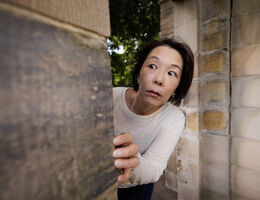
“You’re so much stronger than you feel right now, and please know that there is more to life." — Patti Caskey
After surviving unfavorable memories, lingering looks from others, and convincing herself that stomach issues made her ill, now 56-year-old Patti Caskey sought help for an eating disorder that accompanied her from her teenage years into adulthood.
She really didn’t know she had an eating disorder, at least not consciously. Caskey knew she was slim and had an unhealthy relationship with food. She attributed her struggle to maintain a healthy weight to Chron’s disease. But she neglected food for so long that her body began rejecting the food as well.
It’s not about the food. It’s about the relationship with yourself.
Patti Caskey
With the help of therapy, Caskey pinpointed the exact moments her eating disorder began.
“My sister and I were complete opposites growing up, both our physiques and personalities,” Caskey said. “I did well in school, but I was challenging and talked too much in class. When my parents said I should be more like my sister, referring to her demeanor, I internalized it as looks because I thought I was perfect otherwise.”
This simple misinterpretation as a teen stuck with Caskey and heightened the ramifications of an incident she reflects on often.
The summer before her first year in high school, people Caskey once considered friends started committing petty crimes and engaging in other anti-social behavior — things she told to adults that got her in trouble with her friends. Weeks later, they sat Caskey down and, one by one, exclaimed what they disliked about her, specifically her body, for nearly three hours. This moment began the relationship she had with her self-image for 40 years.
“I went from being an outgoing, self-prospecting, self-confident young girl to a wallflower struggling with my body image. I began hiding things from myself and built an armor that kept everyone away from me because they couldn’t know what happened and what I thought of myself.”
Caskey didn’t share this story with anyone until she began seeing a therapist in her early fifties.
Her story will be a roadmap for others needing help.
Natalie Lagger, Registered Dietician
Her eating disorder began with negative thoughts about herself and how she viewed her body. After high school, Caskey began abusing substances that caused her to lose weight drastically, and she felt confident for the first time in years.
“Drugs bolster your personality and make it feel like your inhibitions go away,” Caskey said. “Then I met my husband and felt real safety. I quit on my own.”
Now happily married and headstrong in her career, Caskey’s eating disorder quieted as she enjoyed the life she created. When excitement turned to stress after opening her CPA firm, she felt like she needed to take control of something; her eating disorder was the one thing she felt she could control.
“This voice of the eating disorder in my head was telling me I could control how much food I put in my body,” Caskey said. “The voice is seductive and easy to get lured into.”
Though she experienced bouts of disordered eating for decades, Caskey says she didn’t realize she had a disorder. Talking through life events, it became easy to recognize when it was prevalent and the patterns surrounding its presence.
Caskey decided she needed help when she began working 12-hour days for six to seven days a week, weighed herself daily, and limited her food intake. It wasn’t easy to admit, especially to her husband, Dean.
“We’ve been married for almost 30 years, and I unconsciously lied to him every single day,” Caskey said. “I felt so ashamed because it was my little secret that I made excuses for.”
She sought programs in the area and found refuge at Loma Linda University Behavioral Medicine Center. The 12-week eating disorder program helped Caskey change her relationship with food, body, and mind. Group therapy allowed her to connect with others and understand what she was experiencing was not unique to her.
“Oh my gosh! It’s not just me,” she often said while listening to the stories of fellow participants.

One-on-one sessions with a clinician equipped Caskey with tools to overcome an eating disorder and create a passion for understanding and dissecting patterns. Family days provided the opportunity for her husband to also learn how to navigate language and behaviors and how to show support. Dean made sure he went to as many as possible.
“He embraced it and made it so comfortable for me. He would participate in the exercises and bring the knowledge home. It made us closer,” Caskey said.
Dieticians like Natalie Lagger, MS, RD, assist with treatment by tailoring meal plans to each individual. She worked with Caskey on eliminating eating disorder behaviors with food and replacing these with healthier and more sustainable coping skills. They worked through nutrition therapy, which included understanding and challenging distortions about food and how to fuel the body properly. Exposure to fear foods created an opportunity to feel neutral towards all foods again and reestablish a healthy relationship with food and body.
“It was a privilege to watch Patti make a complete transformation in the program,” Lagger said. “The eating disorder had taken many years of her life. She worked so hard to free herself from the hold that the eating disorder had on her and is now embracing the recovery that she deserves. Her story will be a roadmap for others needing help.”
Caskey graduated from the program in November with a passion for helping others. She shared her journey in hopes of reaching women and men of all ages whose eating disorder influences their lives.
“It’s not about the food. It’s about the relationship with yourself. You’re so much stronger than you feel right now, and please know that there is more to life,” she said.
Learn more about the eating disorder programs offered at Loma Linda University Behavioral Health. Request more information from an intake coordinator here.


